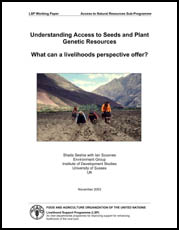 |
LSP Working Paper 6 |
Access to Natural Resources Sub-Programme |
|
|
Understanding Access to Seeds and Plant
Genetic Resources:
What Can a Livelihoods Perspective Offer?
Shaila Seshia with Ian Scoones
Environment Group
Institute of Development Studies
University of Sussex
UK
November 2003
FOOD AND AGRICULTURE ORGANIZATION OF THE UNITED NATIONS
Livelihood Support Programme (LSP)
An inter-departmental programme for improving support for enhancing livelihoods
of the rural poor.
Table of Contents |
The Livelihood Support Programme
The Livelihood Support Programme (LSP) evolved from the belief
that FAO could have a greater impact on reducing poverty and food insecurity, if
its wealth of talent and experience were integrated into a more flexible and
demand-responsive team approach.
The LSP works through teams of FAO staff members, who are
attracted to specific themes being worked on in a sustainable livelihoods
context. These cross-departmental and cross-disciplinary teams act to integrate
sustainable livelihoods principles in FAO’s work, at headquarters and in
the field. These approaches build on experiences within FAO and other
development agencies.
The programme is functioning as a testing ground for both team
approaches and sustainable livelihoods principles.
Email: [email protected]
Access to natural resources sub-programme
Access by the poor to natural resources, including land,
forests, water, fisheries and wildlife, is essential for sustainable poverty
reduction. Landless people in rural areas are particularly vulnerable, because
without secure access to land and other natural resources, they can have more
difficulty obtaining food, accumulating other assets and recovering after
environmental and economic shocks or misfortunes.
The main goal of this sub-programme is to build stakeholder
capacity to improve poor people’s access to natural resources. It also aims
to make sustainable livelihoods approaches more effective in reducing poverty
among the poorest of the poor, particularly landless and near landless
people.
To date, the sub-programme has analysed the relationship
between access to natural resources and sustainable livelihoods, in particular
evaluating the contribution of sustainable livelihoods approaches to an
understanding of the relevant poverty, vulnerability and livelihood
issues.
Table of Contents
Summary
1.
INTRODUCTION
1.1. Introduction: Understanding
Access to Seeds and PGRs
1.2. Using a livelihoods
perspective
1.3. Contributions to FAO's
objectives
1.4. Organization of the
paper
2. SUSTAINABLE LIVELIHOODS - WHAT
CAN IT OFFER?
2.1. Introduction
2.2. Key principles and
frameworks
2.3. Looking at seeds and PGRs through
a sustainable livelihoods lens
2.4. Summary
3. CONTRIBUTION OF SEEDS AND PLANT
GENETIC RESOURCES TO SUSTAINABLE LIVELIHOODS
3.1. Introduction
3.2. Managing
uncertainties
3.3. Maximising productive assets and
strengthening the asset base
3.4. Visible and hidden contributions
of seeds and PGRs to livelihood strategies
3.5. Summary
4. UNDERSTANDING ACCESS: HOW A
SUSTAINABLE LIVELIHOODS PERSPECTIVE CAN INFORM WORK ON
SEEDS/PGRS
4.1. Introduction
4.2. Case 1: Seed Provision in
Emergencies
4.3. Case 2: Wild and Weedy Resources
and Local Crops
4.4. Case 3: Engaging with Research:
Farmers' Access to Plant Genetic Resources
4.5. Summary
5. FUTURE DIRECTIONS: DEVELOPING A
FRAMEWORK FOR ACCESS TO SEEDS/PGRS
5.1. Introduction
5.2. A Framework to Assist Efforts to
Strengthen Access to Seeds and PGRs
5.3. Next Steps
5.4. Concluding Comment
References
FURTHER INFORMATION ABOUT THE LSP
How to Order
